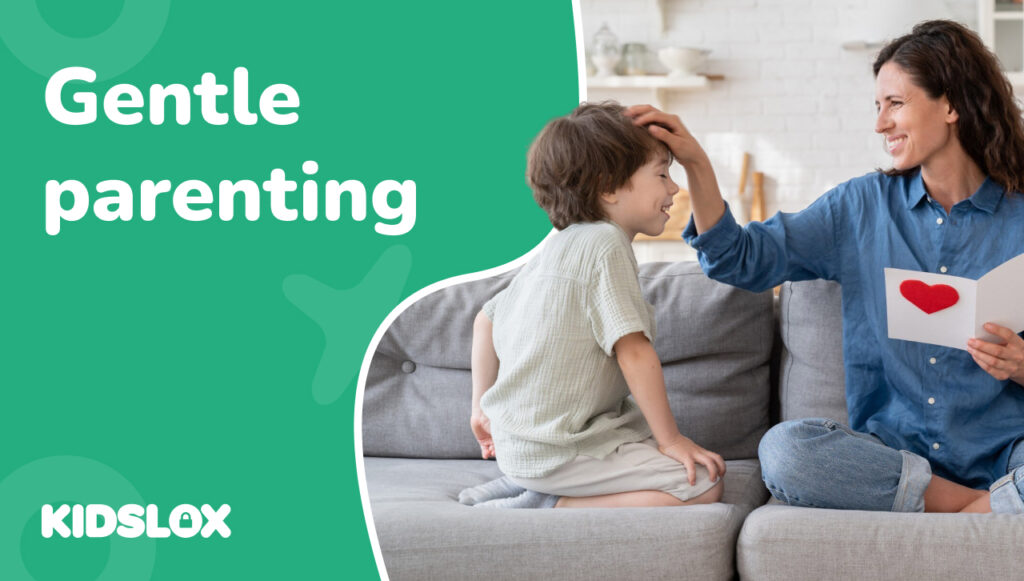What Does This Parenting Approach Really Teach Kids?
“Stop hitting your brother, please. I’d like you to reflect on how that made him feel.”
Cue the eye-rolls. That’s the kind of sentence that’s made gentle parenting the subject of online memes and heated debate. Whether it’s a viral gentle parenting meme about reasoning with a tantrumming toddler in the middle of the supermarket, or a frustrated parent venting that gentle parenting doesn’t work, one thing is clear: everyone seems to have an opinion.
But behind the TikToks and Twitter takes, there’s a real philosophy — one that’s often misunderstood.
What is Gentle Parenting?
At its core, gentle parenting is about respect, empathy, and setting boundaries with kindness. It’s not about being your child’s best friend or giving them everything they want. Instead, it’s a long-term approach that prioritizes connection over control.
So, what is gentle parenting, really? It’s not a single set of rules, but rather a mindset. You might hear it called soft parenting — often dismissively — but that’s a simplification. Gentle parenting encourages parents to consider the child’s perspective, understand the root cause of behaviour, and guide rather than punish.
The gentle parenting definition isn’t “never say no” or “let your kids do what they want.” It’s more like: say no calmly, explain why, and model emotional regulation instead of using threats or bribes.
Gentle Parenting Techniques in Real Life
Let’s say your toddler throws a toy at their sibling. A traditional reaction might be: “That’s naughty! Time out!” A gentle parenting approach might sound more like: “Throwing toys can hurt people. I can’t let you do that. You’re upset — let’s find another way to show that.”
This might sound idealistic, especially in the middle of a stressful day, but gentle parenting discipline doesn’t mean letting bad behaviour slide. In fact, it requires a lot of consistency, patience, and emotional awareness — from the parent more than the child.
Some popular gentle parenting techniques include:
- Naming emotions (“You seem frustrated because…”)
- Validating feelings while still enforcing boundaries
- Setting limits without punishment
- Offering choices and encouraging cooperation
- Modelling emotional regulation
- These aren’t one-time fixes — they’re habits that build over time.
Applying Gentle Parenting Techniques: What It Looks Like in Practice
1. Naming and Validating Emotions
When a child acts out, gentle parenting starts by identifying the emotion driving the behaviour. For example, if your child slams the door after being told no, a gentle response might be:
“It seems like you’re feeling really disappointed. It’s okay to feel that way, but slamming doors isn’t how we handle it.”
This shows your child that emotions are valid but actions have limits. Over time, they begin to develop emotional literacy — the ability to recognize and manage feelings constructively.
2. Setting Boundaries Without Shame
Instead of using punishments like time-outs or shouting, gentle parenting emphasizes calm, clear boundaries. If a child refuses to leave the park, you might say:
“I know it’s hard to leave when you’re having fun. But it’s time to go now. Would you like to walk or shall I carry you?”
This offers choice within limits, giving the child some agency while maintaining your boundary.
3. Rethinking Consequences
Rather than punishing bad behaviour, gentle parenting uses natural and logical consequences. If a child breaks a toy after being warned, the consequence might simply be that the toy isn’t replaced. The focus is on learning cause and effect, not instilling fear.
4. Modelling Calm in Chaos
Children learn how to manage emotions by watching how we do it. When tensions run high, a gentle parent might say:
“I’m feeling really overwhelmed right now, so I’m going to take a few deep breaths before we keep talking.”
This not only de-escalates the situation but also teaches valuable self-regulation skills.
5. Repairing After Conflict
No one parents perfectly all the time. A cornerstone of gentle parenting is repair — coming back together after a hard moment. Saying something like,
“I lost my temper earlier and I’m sorry. I should’ve spoken more kindly,” models accountability and emotional safety.
Where Does the Gentle Parenting Criticism Stem From?
If this sounds too “soft” for some people, that’s because it often is perceived that way. The gentle parenting backlash has been loud and relentless, especially online. Critics argue that it’s unrealistic, overly permissive, or that it fails to prepare children for the “real world.”
Search gentle parenting criticism on any platform, and you’ll see a mix of personal anecdotes, armchair psychology, and frustration from parents who feel they’ve tried it and been let down.
One common critique is that gentle parenting doesn’t work. But this usually reflects a misunderstanding of what gentle parenting is — or how it works over time. It’s not a quick fix for tantrums. It doesn’t make your kid magically compliant. Instead, it focuses on the long game: helping children develop emotional intelligence, trust, and self-discipline.
Another factor driving the backlash? The memes. A gentle parenting meme may exaggerate how a parent responds to a meltdown — often portraying them as overly indulgent or completely ineffective. While funny, these memes shape public perception and contribute to the belief that gentle parenting is ineffective.
And let’s be real — some parenting influencers haven’t helped. Social media often turns complex strategies into oversimplified soundbites. “Just validate their feelings!” isn’t a solution for every scenario, especially if you’re juggling jobs, dishes, and a screaming toddler.
The Problem with Gentle Parenting
That’s not to say the critics are entirely wrong. There are problems with gentle parenting — or more accurately, with how it’s interpreted and applied.
Some parents, trying to follow gentle parenting advice, end up avoiding all conflict or consequences out of fear of being “too harsh.” Others struggle with boundaries, unsure how to set limits without traditional punishments.
The pressure to be endlessly patient, emotionally available, and responsive can be exhausting — especially for parents without support systems or for those healing from their own childhood wounds. Not to mention, many gentle parenting books don’t fully address neurodivergence, trauma, or socioeconomic factors that shape how parenting plays out in real life.
And here’s the truth: gentle parenting doesn’t work if we treat it like a script. It only works when it’s adapted to the needs of the child, the parent, and the context. It’s a toolkit, not a rulebook.
So, Does Gentle Parenting Work?
The answer depends on what you’re measuring.
If your goal is instant obedience, then no — it might not “work” the way you want. But if your goal is to raise emotionally resilient, self-aware, compassionate humans, then research suggests it can be highly effective.
Studies on authoritative parenting — a style that overlaps significantly with gentle parenting — link it with better mental health outcomes, higher self-esteem, and improved social skills in children. While there’s less long-term research specifically on “gentle parenting,” early findings are promising.
Importantly, gentle parenting also encourages parents to examine their own behaviour. It asks: Am I modelling the values I want my child to learn? Am I responding out of love or control? That kind of reflection can lead to real growth — not just for the child, but for the whole family.
Gentle Parenting with Toddlers: The Toughest Test?
If you’ve ever tried gentle parenting a toddler, you’ll know it’s not for the faint of heart. Toddlers test limits, throw tantrums, and push every button you have. In those moments, it’s tempting to abandon empathy in favour of something — anything — that gets them to stop screaming.
But this is exactly where gentle parenting techniques shine. They acknowledge that toddlers don’t yet have the tools to self-regulate, and it’s our job to help them learn. That might mean helping them name their feelings, offering hugs before solutions, or holding a firm boundary without yelling.
Again, it’s not about being passive. Gentle parenting discipline with toddlers means holding the line — with calm authority. “I won’t let you hit. I’m here to help you calm down.” That’s not weakness. That’s strength with empathy.
Moving Past the Criticism
So what is a gentle parenting style when you take away the memes and misunderstandings?
It’s a modern approach rooted in respect, evidence, and connection. It’s about guiding, not controlling. It’s about parenting with your child, not at them. And crucially, it doesn’t mean being perfect — it means being intentional.
It also means tuning out the noise. You don’t have to follow every influencer or agree with every gentle parenting book. You just have to ask yourself: Is my approach building trust? Is it teaching my child something useful? Is it sustainable for me?
Every parenting style has critics, and gentle parenting criticism is no exception. But much of that criticism comes from misunderstanding, unrealistic expectations, or frustration in the face of behaviour that feels unmanageable.
The truth is, gentle parenting isn’t about what you let your kids do. It’s about how you show up for them when they’re struggling. And how you hold boundaries without breaking connection.
It’s okay to adapt it. It’s okay to be imperfect. And it’s okay to admit that some days, it’s really hard.
But if we can move beyond the memes and the backlash, gentle parenting opens the door to more thoughtful, compassionate family dynamics — not just for our kids, but for ourselves.
Whether you’re exploring what is gentle parenting, wrestling with gentle parenting criticism, or just trying to survive a day with a cranky toddler, remember: parenting isn’t about getting it “right” all the time.
It’s about learning, adapting, and showing up — with as much empathy and grace as we can manage.





